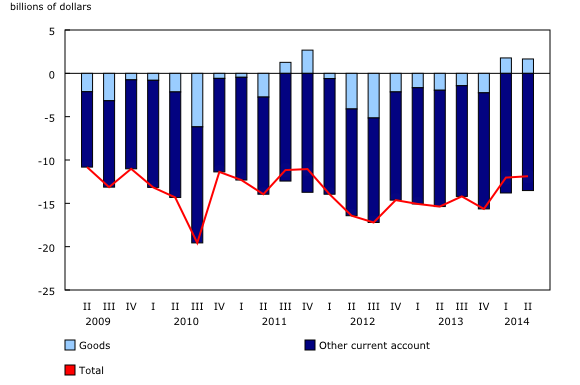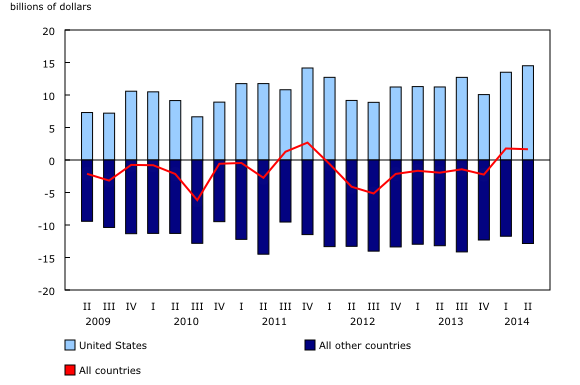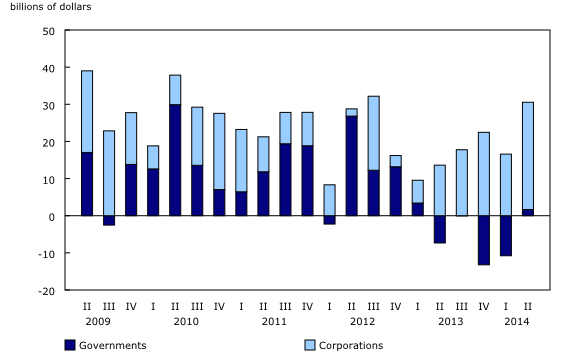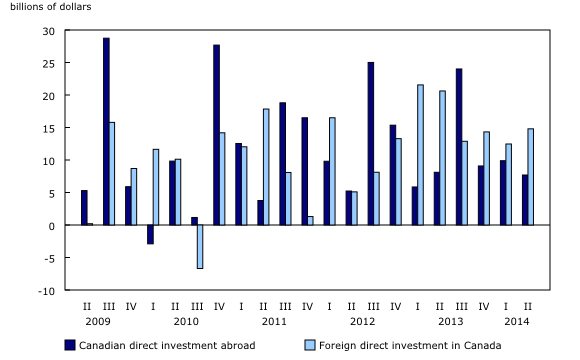Canada's balance of international payments, second quarter 2014
Archived Content
Information identified as archived is provided for reference, research or recordkeeping purposes. It is not subject to the Government of Canada Web Standards and has not been altered or updated since it was archived. Please "contact us" to request a format other than those available.
Released: 2014-08-28
Canada's current account deficit (on a seasonally adjusted basis) was largely unchanged in the second quarter, edging down $0.2 billion to $11.9 billion. This reflected a slight increase in the deficit on trade in goods and services, which was more than offset by a lower investment income deficit.
In the financial account (unadjusted for seasonal variation), foreign investment in Canadian corporate securities remained strong and led the inflow of funds in the economy in the second quarter.
Current account
The trade in goods remains in a surplus position
The balance on international trade in goods posted a $1.7 billion surplus in the second quarter, down $0.1 billion from the previous quarter. Both exports and imports strengthened during the quarter. On a geographical basis, the trade surplus with the United States increased by $1.0 billion to $14.5 billion as exports reached a record level. The trade deficit with other countries expanded, led by a higher deficit with European Union countries.
Total exports of goods increased by $3.9 billion to a record $132.3 billion in the second quarter. Exports of motor vehicles and parts led the growth, up by $1.9 billion. This increase largely reflected stronger volumes of passenger cars and light trucks sold abroad, mainly in the United States.
Farm, fishing and intermediate food products were up $0.7 billion to $8.1 billion, with higher volumes of canola accounting for half of the increase. Forestry products rose $0.6 billion to $9.3 billion on higher volumes of lumber and pulp and paper. This was the highest such level of exports since the third quarter of 2007.
Energy products were down $1.2 billion to $33.6 billion. Crude petroleum exports increased $2.0 billion on higher prices and volumes. Natural gas lost $2.4 billion, about two-thirds accounted for by lower prices following strong price gains in previous quarters.
Overall imports of goods increased $4.0 billion to $130.7 billion. Imports of motor vehicle and parts were up $1.6 billion to $22.7 billion as cars, trucks, and parts all increased on higher volumes. Consumer goods advanced $1.2 billion to $26.8 billion, with gains widespread across several commodities. Chemical, plastic and rubber products increased $1.0 billion on stronger volumes. Energy products declined $0.8 billion to $10.8 billion, mainly on lower volumes of crude petroleum and refined petroleum products. Imports of natural gas increased by $0.4 billion to a record high $1.7 billion.
Deficit on trade in services edges up
The deficit on international transactions in services edged up $0.1 billion to $6.3 billion in the second quarter. The surplus on commercial services was unchanged at $0.9 billion, as both receipts and payments advanced.
The transportation deficit increased $0.1 billion to $2.7 billion. Both receipts and payments were up in the quarter, mainly on higher passenger fares. The deficit in international travel was unchanged at $4.6 billion and reflected higher expenditures by foreign travellers in Canada, which were offset by increased spending by Canadians in foreign countries other than the United States.
The deficit on investment income edges down
The deficit on cross-border investment income flows was down $0.5 billion to $5.8 billion in the second quarter, as receipts were up by more than payments.
On the receipt side, profits of Canadian direct investors on their operations abroad advanced $0.4 billion. Higher earnings on deposit and loan assets also contributed to the increase in overall receipts in the quarter.
On the payments side, income paid to non-residents on their holdings of Canadian securities rose $0.2 billion in the second quarter, reflecting higher acquisitions of corporate portfolio instruments by non-residents. Profits earned by foreign direct investors on their operations in Canada were unchanged at $11.1 billion.
Financial account
Foreign portfolio investment in Canada focuses on corporate securities
Foreign investors increased their holdings of Canadian securities by $30.6 billion in the second quarter, after acquiring $5.8 billion in the first quarter. Foreign acquisitions of corporate debt securities led the inflows and were the highest since the fourth quarter of 2001.
Non-resident investors acquired $14.5 billion of Canadian bonds in the quarter, all corporate bonds from both private corporations and government business enterprises. At the same time, foreign holdings of Canadian government bonds were down for a fifth consecutive quarter. This decline reflected large retirements of federal government bonds held by non-residents in May and June.
Foreign investment in the Canadian money market totalled $7.2 billion, following a $5.2 billion divestment in the first quarter. Inflows were evenly split between the government, mainly provincial, and the corporate sectors.
Non-resident investors also added $8.8 billion of Canadian equities to their portfolio in the second quarter, all secondary market purchases. This was on par with the average investment observed in the past five quarters. Canadian stock prices advanced 5.7% while the Canadian dollar gained 3.3 US cents in the second quarter.
Canadian investment in foreign securities slows
Canadian investors acquired $6.3 billion of foreign securities in the second quarter, down by more than $10 billion from a strong first quarter.
Canadian purchases of foreign stocks were $8.7 billion, led by non-US foreign shares. Acquisitions of foreign equities since the beginning of the year totalled $19.4 billion, compared with $2.4 billion for the two first quarters of 2013.
Canadian holdings of foreign debt securities were down by $2.4 billion, the first decline in more than two years. On an instrument basis, Canadian investment in foreign paper and in non-US foreign bonds was more than offset by the largest quarterly divestment in US Treasury bonds in three years.
Inward direct investment surpasses outward direct investment for a third straight quarter
Foreign direct investment in Canada was $14.8 billion in the second quarter while Canadian direct investment abroad remained moderate at $7.7 billion. This led to the highest net inflow of funds from the direct investment category in a year. Cross-border mergers and acquisitions activity, both inward and outward, slowed in the quarter.
The manufacturing as well as the energy and mining sectors accounted for the bulk of the foreign direct investment in Canada over the quarter. Meanwhile, Canadian direct investment abroad was widespread across most industries and mainly reflected earnings of Canadian direct investors re-invested in foreign subsidiaries.
Other investment assets increase
Transactions in the other investment category of the financial account generated a net outflow of funds of $16.9 billion in the second quarter, following large inflows in the previous three quarters. On an instrument basis, this activity was led by an increase in loan assets.
Note to readers
The balance of international payments covers all economic transactions between Canadian residents and non-residents in three accounts: the current account, the capital account and the financial account.
The current account covers transactions in goods, services, compensation of employees, investment income and secondary income (current transfers).
The current account data in this release are seasonally adjusted. For more information on seasonal adjustment, see Seasonally adjusted data – Frequently asked questions.
The capital account covers capital transfers and transactions in non-produced non-financial assets.
The financial account comprises transactions in financial assets and liabilities.
In principle, a net lending (+) / net borrowing (-) derived from the sum of the current and capital accounts corresponds to a net lending (+) / net borrowing (-) derived from the financial account. In practice, as data are compiled from multiple sources, this is rarely the case and gives rise to measurement error. The discrepancy (net errors and omissions) is the unobserved net inflow or outflow.
Change to annual revision practices
The Canadian System of macroeconomic accounts is implementing a new revision policy. Annual revisions for Canada's international balance of payments, which affect the three most recent calendar years, will take place in November rather than May, as was previously the practice. For more information, see Latest Developments in the Canadian Economic Accounts (Catalogue number13-605-X).
New details on trade in goods and services
Beginning with the third quarter release of the balance of international payments in November 2014, expanded geographical details on trade in goods and trade in services data will be available. The new quarterly data will cover the period from the first quarter of 1997 to the third quarter of 2014, and will subsequently be updated with the quarterly release of the balance of payments.
For more information about the balance of payments, consult the "Frequently asked questions" section in the System of macroeconomic accounts module of our website. The module also presents the most recent balance of payments statistics.
The balance of international payments data for the third quarter will be released on November 27.
Contact information
For more information, contact us (toll-free 1-800-263-1136; 514-283-8300; infostats@statcan.gc.ca).
To enquire about the concepts, methods or data quality of this release, contact Denis Caron (613-951-1861; denis.caron@statcan.gc.ca), International Accounts and Trade Division.
- Date modified:





